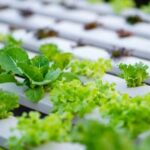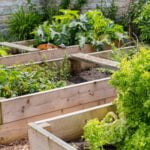Is colored mulch good for vegetable gardens? Understanding the benefits and impact of colored mulch on soil and plant health is essential for gardeners. In this article, we will explore the role of mulch in vegetable gardens and delve into the pros and cons of using colored mulch. We will also provide expert recommendations and tips for choosing the right colored mulch for your vegetable garden.
Mulch plays a crucial role in maintaining soil moisture, regulating temperature, suppressing weed growth, and improving soil structure in vegetable gardens. Colored mulch, a popular choice among gardeners, offers additional benefits such as enhancing visual appeal, heat retention, and weed control. With its rising popularity, it is important to understand whether colored mulch is a suitable option for your vegetable garden.
In the following sections, we will discuss the different types of colored mulch available and how they can impact your soil and plant health. By weighing the pros and cons, you will gain valuable insights into making an informed decision on whether to use colored mulch in your vegetable garden. Additionally, we will provide application and maintenance tips alongside case studies to showcase success stories of using colored mulch in vegetable gardens.
Understanding Colored Mulch
Colored mulch has become a popular choice for both ornamental gardens and vegetable gardens due to its aesthetic appeal and potential benefits for plant health. Understanding the different types of colored mulch and their associated benefits can help gardeners make an informed decision when considering this option for their vegetable garden.
Types of Colored Mulch
There are several types of colored mulch available on the market, including black, brown, red, and even reflective silver or white. Each type of colored mulch is achieved through the use of non-toxic dyes that are safe for plants and the environment. The choice of color may depend on personal preference, but it is important to consider how different colors may impact soil temperature and moisture levels in the vegetable garden.
Benefits of Colored Mulch
One of the primary benefits of using colored mulch in vegetable gardens is its ability to enhance soil moisture retention. This can be especially beneficial during hot summer months when water evaporation from the soil is high. Additionally, certain colors such as black or dark brown can help absorb more heat from the sun, potentially warming the soil and extending the growing season for certain vegetable crops.
Another benefit is weed suppression, as colored mulch acts as a barrier to inhibit weed growth around vegetable plants. Furthermore, some studies have suggested that certain types of colored mulch may have insect-repelling properties, which could help protect vegetable plants from pests.
The Pros and Cons of Using Colored Mulch in Vegetable Gardens
Colored mulch has become a popular choice for many gardeners looking to add a decorative touch to their vegetable gardens. However, it is important to weigh the pros and cons before deciding whether colored mulch is the right option for your vegetable garden.
One of the main benefits of using colored mulch in vegetable gardens is its aesthetic appeal. Colored mulch comes in a variety of hues, allowing gardeners to choose a shade that complements their overall garden design. Additionally, colored mulch has been found to help retain soil moisture, regulate soil temperature, and suppress weed growth. These factors can contribute to healthier plant growth and higher yields in vegetable gardens.
On the other hand, there are some disadvantages to consider when using colored mulch in vegetable gardens. One potential drawback is the use of dyed wood products, which may contain chemicals that could leach into the soil and affect plant health. Additionally, some types of colored mulch may not break down as quickly as natural mulches, which can impact soil fertility over time.
When considering whether to use colored mulch in your vegetable garden, it is important to weigh these pros and cons carefully before making a decision. While colored mulch can add visual interest and offer practical benefits such as weed suppression and moisture retention, it is essential to be mindful of any potential long-term effects on soil and plant health.
Impact of Colored Mulch on Soil and Plant Health
When it comes to using colored mulch in vegetable gardens, one of the most important considerations is its impact on soil and plant health. Here are some key points to keep in mind:
- Soil Temperature Regulation: One of the benefits of colored mulch is its ability to regulate soil temperature. This can be especially beneficial for vegetable gardens, as it can help protect plants from extreme temperatures and promote healthy root development.
- Weed Suppression: Colored mulch, particularly black mulch, is effective in suppressing weed growth. By preventing weeds from taking over your vegetable garden, colored mulch can help maintain soil health and reduce competition for nutrients among your crops.
- Moisture Retention: Another advantage of using colored mulch in vegetable gardens is its ability to retain moisture in the soil. This can be particularly important during dry periods, as it helps ensure that your plants have access to the water they need for optimal growth.
Despite these benefits, it’s important to consider some potential drawbacks of using colored mulch in vegetable gardens:
- Potential Chemical Leaching: Some colored mulches contain dyes and chemicals that could potentially leach into the soil over time. This has raised concerns about the impact of these substances on soil and plant health, particularly when growing edible crops.
- Soil pH Alteration: Certain types of colored mulch may alter the pH levels of the soil over time. This could have implications for the nutrients available to your plants, so it’s important to monitor pH levels closely if you choose to use colored mulch in your vegetable garden.
- Microbial Activity: The presence of certain types of colored mulch could affect microbial activity in the soil. Since beneficial microorganisms play a crucial role in maintaining soil health, it’s essential to assess how different types of colored mulch may impact microbial communities.
Overall, while there are definite advantages to using colored mulch in vegetable gardens, it’s essential to consider both the potential benefits and drawbacks before making a decision for your specific gardening needs.
Choosing the Right Colored Mulch for Your Vegetable Garden
When choosing the right colored mulch for your vegetable garden, there are several factors to consider in order to ensure the health and success of your plants. Different types and colors of mulch can have varying effects on the soil and plant growth, so it’s important to make an informed decision.
Types of Colored Mulch
There are several types of colored mulch available, including black, red, brown, and even green. Each type has its own unique properties and can affect the soil and plant health in different ways. It’s important to understand the characteristics of each type before making a choice for your vegetable garden.
Considerations for Vegetable Gardens
When choosing colored mulch for your vegetable garden, it’s essential to consider the specific needs of your plants. Some colored mulches may be more suitable for certain types of vegetables based on their nutrient requirements and growth habits. For example, certain colors may retain more heat or moisture, which could benefit some vegetables but harm others.
Environmental Impact
In addition to considering the needs of your plants, it’s also important to think about the environmental impact of colored mulch. Some dyes used in colored mulch may contain chemicals or additives that could potentially leach into the soil and affect plant growth. It’s crucial to choose a colored mulch that is not only beneficial for your vegetable garden but also environmentally friendly.
By carefully considering these factors and doing thorough research on the different types of colored mulch available, you can make an informed decision when choosing the right one for your vegetable garden. Ultimately, selecting the most suitable colored mulch will contribute positively to the health and productivity of your vegetable plants.
Application and Maintenance Tips for Colored Mulch in Vegetable Gardens
When it comes to using colored mulch in your vegetable garden, there are a few important application and maintenance tips to keep in mind. First, it’s essential to properly prepare the soil before applying the mulch. This involves removing any weeds or debris, loosening the soil, and adding any necessary nutrients or fertilizers. Once the soil is ready, you can apply a layer of colored mulch around your vegetable plants.
In terms of maintenance, it’s important to regularly check the mulch for signs of compaction or erosion. Compacted mulch can prevent water and air from reaching the soil, while excessively eroded mulch may not provide adequate protection for the plants. It’s also recommended to replenish the mulch as needed, especially after heavy rainfall or strong winds.
Another key tip for maintaining colored mulch in vegetable gardens is to monitor for any signs of mold or fungal growth. While colored mulch can enhance the visual appeal of your garden, it’s important to ensure that it doesn’t harbor any harmful microbes that could affect plant health. Regularly inspecting the mulch and promptly removing any affected areas can help prevent these issues from escalating.
| Application and Maintenance Tips | Details |
|---|---|
| Prepare the Soil | Remove weeds and debris, loosen soil, add nutrients |
| Mulch Maintenance | Check for compaction and erosion; replenish as needed |
| Fungal Growth Monitoring | Regularly inspect for mold or fungal growth and remove affected areas |
By following these application and maintenance tips, you can effectively utilize colored mulch in your vegetable garden while promoting healthy plant growth.
Case Studies and Success Stories of Using Colored Mulch in Vegetable Gardens
Using colored mulch in vegetable gardens can have varying effects, and many gardeners have reported both positive and negative outcomes. One success story comes from a gardener who used red mulch in their tomato garden.
They found that the red mulch helped to increase the yield of their tomatoes and also deterred pests such as nematodes. This is consistent with research that shows certain colors of mulch, such as red and black, can help to improve plant growth and deter harmful insects.
Another case study involves a vegetable garden that used colored mulch made from recycled materials. The gardeners reported that the mulch helped to retain moisture in the soil, reduce weed growth, and improve the overall appearance of the garden. This demonstrates how using colored mulch not only benefits plant health but also has practical advantages for garden maintenance.
It’s important to note that while there are success stories when using colored mulch in vegetable gardens, there are also instances where it may not be ideal. For example, some gardeners have found that certain colors of mulch had no significant impact on their vegetable plants, or even hindered growth due to heat retention or altered soil pH levels.
Therefore, it’s crucial for gardeners to consider the specific needs of their plants and evaluate whether colored mulch is suitable for their particular vegetable garden.
| Effect | Outcome |
|---|---|
| Increased tomato yield | Positive |
| Retained moisture, reduced weeds | Positive |
| No impact or hindered growth | Negative |
Expert Recommendations
In conclusion, the use of colored mulch in vegetable gardens can be a beneficial and aesthetic choice for many gardeners. While there are some potential drawbacks to consider, such as the impact on soil pH and the environment, the benefits of using colored mulch often outweigh these concerns. This type of mulch not only helps to suppress weeds and conserve moisture but can also enhance the overall appearance of a vegetable garden.
It is important to carefully consider the type of colored mulch that you choose for your vegetable garden, taking into account its specific benefits and any potential drawbacks. Different colors can have different effects on soil temperature, water retention, and plant health. Therefore, it is essential to select a colored mulch that aligns with the needs of your particular vegetables and growing conditions.
Ultimately, whether colored mulch is good for your vegetable garden depends on a variety of factors, including your gardening goals, the climate in which you live, and the specific vegetables you are growing. Consulting with local gardening experts or horticulturists may provide valuable insight into whether colored mulch is a suitable option for your individual needs. With proper consideration and application, colored mulch has the potential to enhance both the productivity and visual appeal of your vegetable garden.
Frequently Asked Questions
What Color Mulch Is Best for Vegetable Garden?
The best color mulch for a vegetable garden is natural, dark-colored mulch such as black, brown, or dark hardwood. These colors help retain moisture, suppress weeds, and regulate soil temperature, which are all beneficial for vegetable plants.
Is It OK to Put Dyed Mulch in a Vegetable Garden?
It is generally not recommended to put dyed mulch in a vegetable garden. The dyes used in colored mulch may contain chemicals that can leach into the soil and be absorbed by the vegetables. It’s better to opt for natural mulch to avoid any potential harm to edible plants.
What Are the Disadvantages of Colored Mulch?
One disadvantage of colored mulch is that the dyes used can contain heavy metals and other harmful chemicals that may negatively impact soil quality and plant health over time. Additionally, colored mulch may fade quickly under sunlight exposure, requiring more frequent replacement compared to natural mulches.

If you’re looking to get into vegetable gardening, or are just looking for some tips on how to make your current garden better, then you’ve come to the right place! My name is Ethel and I have been gardening for years. In this blog, I’m going to share with you some of my best tips on how to create a successful vegetable garden.





